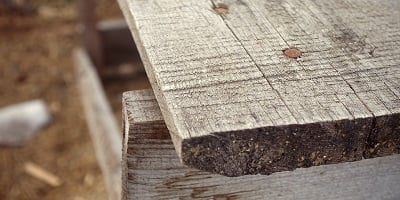Rusty, corroded fasteners—it’s a common problem on jobsites, especially retrofits in which you’re working with lumber that has been exposed to the elements for a while. Moisture is a big part of the problem. Research shows that corrosion rates are at zero when lumber contains up to 15% moisture content, but spike sharply to a maximum rate around 30% moisture content. Of course, there are lots of other variables that can affect the rates listed above, but the point is, where moisture is present, rust and corrosion can happen.
What’s the workaround? In many cases moisture is unavoidable when dealing with decks, agricultural fencing, foundation work, and so on. That means you need products with corrosion protection, like SCRAIL® with FasCoat®. But first, let’s talk about how corrosion happens so that you can better understand how to avoid it!
How Corrosion Happens
Corrosion is a chemical reaction that requires two basic ingredients: water and air. Water combines with carbon dioxide in the air to create a weak acid known as carbonic acid.
Here’s where it all goes wrong for rust-prone fasteners. When carbonic acid reaches iron, the electrolytes in it remove some of the iron’s electrons, which dissolves some of it. As this happens, the water breaks down into its component parts: oxygen and hydrogen. The oxygen molecules react with the dissolved iron molecules to form iron oxide, which is rust.
That’s the basics on how rust happens—but there are a variety of factors that can speed or slow the process. Increased moisture is the big one that will speed up rusting, but even factors like wood species will have an effect since tannins and other compounds can increase the rate of rust or corrosion.
A Cumulative Process
Once rust starts, as long as there’s a steady supply of moisture, it isn’t likely to stop. Therefore, you’ll often see things like, cast iron painted with a black paint to seal the metal—that helps keep moisture away to prevent rust from happening.
However, when this process is left to run unchecked it will wreak havoc on fasteners. At the outset, it will turn red in spots until the entire surface is covered. Eventually, it will become scaly as chunks of rust expand. By the end of the process, the fastener will become brittle enough that you can easily break it in your hands. By that point, it doesn’t have much holding power left as a fastener.
Where your build is concerned, that means trouble. In the worst-case scenario, rusted fasteners could lead to collapse. On decks, it could mean that decking boards come loose, or that vital structural beams are no longer capable of carrying the load that they once could. The same thing happens when building pallets or crating. Rusted fasteners will make the pallet or crate unable to stand up to the load it's carrying and cause it to collapse, leading to damaged products.
All of these issues are why fastener technology is so important—and why BECK continues to innovate. SCRAIL® with FasCoat® from BECK feature a proprietary finish that has been designed to withstand testing in accordance with ASTM B117, which means SCRAIL® with the FasCoat® finish holds up to 2,000 hours, and more, of salt spray before showing significant signs of red rust. What this means for you is cost-efficient corrosion protection that lasts longer than other types of fasteners.
.svg.png)


